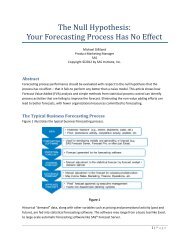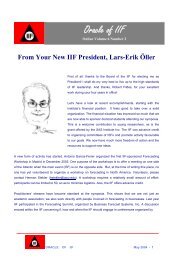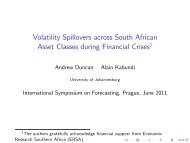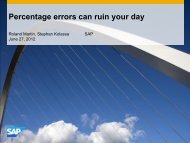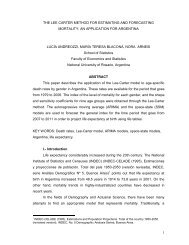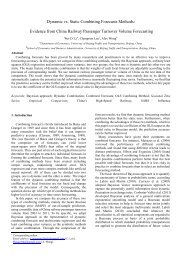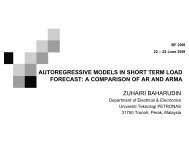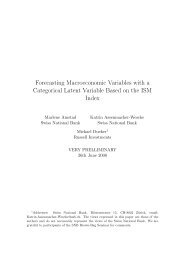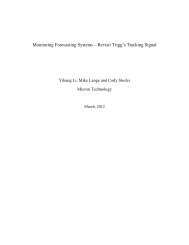Observation and Analysis for the Semiconductor Cycle with a State ...
Observation and Analysis for the Semiconductor Cycle with a State ...
Observation and Analysis for the Semiconductor Cycle with a State ...
You also want an ePaper? Increase the reach of your titles
YUMPU automatically turns print PDFs into web optimized ePapers that Google loves.
The 31st Annual International Symposium on Forecasting, June 26-30, Prague, University of Economics<br />
<strong>Observation</strong> <strong>and</strong> <strong>Analysis</strong> <strong>for</strong><br />
<strong>the</strong> <strong>Semiconductor</strong> <strong>Cycle</strong> <strong>with</strong><br />
a <strong>State</strong> Space Model<br />
Takashi Ogawa<br />
Graduate School of Business Science<br />
University of Tsukuba<br />
ogawa@gssm.otsuka.tsukuba.ac.jp
Agenda<br />
1. Motivation <strong>and</strong> Background<br />
2. <strong>Semiconductor</strong> Market<br />
3. Modeling<br />
4. <strong>Analysis</strong> <strong>and</strong> Consideration<br />
5. Summary of results<br />
Graduate School of Business Science/University of Tsukuba<br />
2
Motivation <strong>and</strong> Background:<br />
<strong>Semiconductor</strong> <strong>Cycle</strong>s<br />
Change %<br />
100<br />
80<br />
60<br />
40<br />
20<br />
0<br />
-20<br />
-40<br />
-60<br />
Semicondoctor market<br />
<strong>Semiconductor</strong> manufacfuring equipment market<br />
1990 1995 2000 2005<br />
• Cyclical behaviors in<br />
semiconductor markets have<br />
been well-known as “Silicon<br />
<strong>Cycle</strong>”<br />
• Influential factors <strong>for</strong> <strong>the</strong><br />
behaviors from observations<br />
– Business cycles<br />
– Unbalance of supply <strong>and</strong><br />
dem<strong>and</strong><br />
– Memory cycles <strong>with</strong> periodical<br />
technology shifts<br />
• Expectation <strong>for</strong> modulations<br />
– Consolidation of industry<br />
– Diversification in electronics<br />
dem<strong>and</strong><br />
Graduate School of Business Science/University of Tsukuba<br />
3
Motivation <strong>and</strong> Background:<br />
Reviews <strong>for</strong> <strong>the</strong> Past Research<br />
• Academic research <strong>for</strong> “Silicon <strong>Cycle</strong>” has been limited in <strong>the</strong> past<br />
– Many analysts have given <strong>the</strong> qualitative view <strong>and</strong> speculation <strong>for</strong> <strong>the</strong><br />
market behaviors time to time<br />
– Okada(1993): Speculated “<strong>Semiconductor</strong> Waves” in semiconductor revenue at a<br />
technology shift of DRAM <strong>with</strong> a drastic bit price decline<br />
• In <strong>the</strong>se days, <strong>the</strong> accumulated market data during over 20 years<br />
in <strong>the</strong> past becomes available <strong>for</strong> <strong>the</strong> quantitative analysis <strong>and</strong><br />
modeling<br />
– Chow(2007): Constructed a leading indicator <strong>for</strong> <strong>the</strong> electronics cycle <strong>with</strong> Bayesian<br />
VAR model<br />
– Ogawa(2010): Simulated “Periodic behaviors” in DRAM market <strong>with</strong> SD model <strong>and</strong><br />
evaluated effects of time-delay <strong>and</strong> over expectation in <strong>the</strong> capacity investment<br />
• The purposes of this research are;<br />
– Investigate <strong>the</strong> feasibility <strong>for</strong> quantitative model <strong>with</strong> st<strong>and</strong>ard statistical approach<br />
(<strong>State</strong> Space Model)<br />
– Through <strong>the</strong> analysis, <strong>with</strong>draw <strong>the</strong> influential factors <strong>and</strong> characteristics <strong>for</strong> <strong>the</strong><br />
cyclical behaviors to underst<strong>and</strong> <strong>the</strong> dynamics<br />
Graduate School of Business Science/University of Tsukuba<br />
4
<strong>Semiconductor</strong> Market:<br />
Data Categories<br />
<strong>Semiconductor</strong><br />
market<br />
1.Analog<br />
2.Discrete<br />
3.Logic<br />
4.Memory<br />
5.Micro<br />
component<br />
6.Optoelectronics<br />
• Data source: Worldwide<br />
Trading <strong>Semiconductor</strong><br />
Statistics<br />
• Period <strong>for</strong> analysis: 1985<br />
January – 2008 December<br />
• Six major categories <strong>for</strong><br />
semiconductor devices<br />
• Monthly revenue data is<br />
incorporated into <strong>the</strong><br />
model <strong>and</strong> analyzed<br />
Graduate School of Business Science/University of Tsukuba<br />
5
Modeling:<br />
Structural Time Series Model<br />
• Structural Time Series Model (Harvey 1989) represents Time<br />
series observations (y n : n=1,..,T) by a linear combination of<br />
Trend(t n ), Seasonality(s n ), <strong>and</strong> <strong>Cycle</strong>(c n )<br />
y<br />
t<br />
s<br />
c<br />
n<br />
n<br />
n<br />
n<br />
<br />
<br />
t<br />
i1<br />
q<br />
i1<br />
i<br />
s<br />
n n<br />
k<br />
(k)<br />
ci<br />
tni<br />
i1<br />
p1<br />
<br />
<br />
<br />
<br />
s<br />
c<br />
<br />
ni<br />
ni<br />
c<br />
n<br />
<br />
<br />
<br />
<br />
n2<br />
n1<br />
n3<br />
,<br />
,<br />
,<br />
n<br />
~<br />
~<br />
~<br />
~<br />
Graduate School of Business Science/University of Tsukuba<br />
,<br />
<br />
<br />
<br />
n<br />
n1<br />
<br />
n2<br />
n3<br />
N(0, <br />
N(0, <br />
2<br />
2<br />
1<br />
N(0, <br />
N(0, <br />
)<br />
)<br />
2<br />
2<br />
2<br />
3<br />
)<br />
)<br />
6
Modeling: Structural Time Series Model<br />
<strong>for</strong> <strong>Semiconductor</strong> Market<br />
• Multivariate structural time series model could be<br />
applied <strong>for</strong> semiconductor market data<br />
y<br />
y<br />
t<br />
s<br />
c<br />
i, n<br />
i,n<br />
i,n<br />
n<br />
<strong>Cycle</strong> factor<br />
n<br />
<br />
:Time<br />
<br />
<br />
t<br />
2t<br />
q<br />
j1<br />
i,n<br />
p1<br />
<br />
j1<br />
<br />
s<br />
j<br />
s<br />
i,n 2<br />
c<br />
series<br />
n<br />
n<br />
j<br />
n<br />
j<br />
t<br />
c<br />
observations<br />
i,n 1<br />
<br />
<br />
n<br />
n2<br />
,<br />
n3<br />
<br />
,<br />
n<br />
<br />
,<br />
n1<br />
,<br />
<br />
<br />
<br />
n<br />
n2<br />
n3<br />
<strong>for</strong> device category (i),<br />
~<br />
<br />
~<br />
~<br />
N(0, <br />
n1<br />
~<br />
N(0, <br />
N(0, <br />
N(0, <br />
2<br />
2<br />
2<br />
i<br />
2<br />
3<br />
),<br />
)<br />
)<br />
2<br />
i, 1<br />
)<br />
p 12<br />
i 1,....,6<br />
Graduate School of Business Science/University of Tsukuba<br />
7
<strong>Analysis</strong> <strong>and</strong> Consideration: <strong>Analysis</strong> <strong>for</strong><br />
<strong>Semiconductor</strong> Market<br />
400<br />
200<br />
0<br />
Std. Residuals<br />
Actual<br />
Predicted<br />
ANALOG M$<br />
4,000<br />
3,000<br />
2,000<br />
1,000<br />
0<br />
400<br />
200<br />
0<br />
Std. Residuals<br />
Actual<br />
Predicted<br />
MEMORY M$<br />
8,000<br />
6,000<br />
4,000<br />
2,000<br />
0<br />
-200<br />
-200<br />
-400<br />
-400<br />
-600<br />
200<br />
0<br />
-200<br />
88 90 92 94 96 98 00 02 04 06 08<br />
Std. Residuals<br />
Actual<br />
Predicted<br />
DISCRETE M$<br />
400 -500<br />
3,000<br />
2,500<br />
2,000<br />
1,500<br />
1,000<br />
500<br />
0<br />
-600<br />
2,000<br />
1,000<br />
0<br />
-1,000<br />
88 90 92 94 96 98 00 02 04 06 08<br />
Std. Residuals<br />
Actual<br />
Predicted<br />
MICROCOMPONENT M$<br />
10,000<br />
8,000<br />
6,000<br />
4,000<br />
2,000<br />
0<br />
-400<br />
88 90 92 94 96 98 00 02 04 06 08<br />
Std. Residuals<br />
Actual<br />
Predicted<br />
LOGIC M$<br />
8,000<br />
6,000<br />
-2,000<br />
88 90 92 94 96 98 00 02 04 06 08<br />
Std. Residuals<br />
Actual<br />
Predicted<br />
OPTOELECTRONICS M$<br />
4,000<br />
3,000<br />
2,000<br />
4,000<br />
1,000<br />
800<br />
400<br />
0<br />
2,000<br />
0<br />
800<br />
400<br />
0<br />
0<br />
-1,000<br />
-400<br />
-800<br />
88 90 92 94 96 98 00 02 04 06 08<br />
Graduate School of Business Science/University of Tsukuba<br />
-400<br />
-800<br />
88 90 92 94 96 98 00 02 04 06 08<br />
8
<strong>Analysis</strong> <strong>and</strong> Consideration:<br />
Changes in Cyclical Behaviors <strong>with</strong> <strong>the</strong> Lag Orders<br />
in <strong>Cycle</strong> Factor<br />
<strong>Cycle</strong> factor<br />
c<br />
n<br />
<br />
q<br />
<br />
j1<br />
j<br />
c<br />
n<br />
j<br />
<br />
n3<br />
,<br />
<br />
n3<br />
~<br />
N(0, <br />
2<br />
3<br />
)<br />
q=6~9<br />
200<br />
Smoo<strong>the</strong>d SV3 <strong>State</strong> Estimate<br />
200<br />
Smoo<strong>the</strong>d SV3 <strong>State</strong> Estimate<br />
600<br />
Smoo<strong>the</strong>d SV3 <strong>State</strong> Estimate<br />
300<br />
Smoo<strong>the</strong>d SV3 <strong>State</strong> Estimate<br />
150<br />
500<br />
200<br />
100<br />
50<br />
100<br />
400<br />
300<br />
100<br />
0<br />
0<br />
200<br />
0<br />
-50<br />
100<br />
-100<br />
-100<br />
-100<br />
0<br />
-200<br />
-150<br />
-100<br />
-200<br />
-200<br />
-300<br />
-200<br />
88 90 92 94 96 98 00 02 04 06 08<br />
88 90 92 94 96 98 00 02 04 06 08<br />
88 90 92 94 96 98 00 02 04 06 08<br />
88 90 92 94 96 98 00 02 04 06 08<br />
q=10~13<br />
SV3 ± 2 RMSE<br />
SV3 ± 2 RMSE<br />
SV3 ± 2 RMSE<br />
SV3 ± 2 RMSE<br />
Smoo<strong>the</strong>d SV3 <strong>State</strong> Estimate<br />
Smoo<strong>the</strong>d SV3 <strong>State</strong> Estimate<br />
Smoo<strong>the</strong>d SV3 <strong>State</strong> Estimate<br />
Smoo<strong>the</strong>d SV3 <strong>State</strong> Estimate<br />
400<br />
400<br />
400<br />
300<br />
300<br />
300<br />
300<br />
200<br />
q=11<br />
200<br />
200<br />
100<br />
200<br />
100<br />
100<br />
0<br />
100<br />
0<br />
0<br />
-100<br />
0<br />
-100<br />
-100<br />
-200<br />
-100<br />
-200<br />
-300<br />
-200<br />
-200<br />
-300<br />
-400<br />
-300<br />
88 90 92 94 96 98 00 02 04 06 08<br />
88 90 92 94 96 98 00 02 04 06 08 -300<br />
88 90 92 94 96 98 00 02 04 06 08<br />
88 90 92 94 96 98 00 02 04 06 08<br />
SV3 ± 2 RMSE<br />
SV3 ± 2 RMSE<br />
SV3 ± 2 RMSE<br />
SV3 ± 2 RMSE<br />
Graduate School of Business Science/University of Tsukuba<br />
9
<strong>Analysis</strong> <strong>and</strong> Consideration:<br />
<strong>Observation</strong> of Cyclical Behavior in <strong>Semiconductor</strong><br />
Market<br />
Smoo<strong>the</strong>d SV3 cycle <strong>State</strong> Estimate (C <strong>State</strong> SV3 Estimate<br />
n : q=11)<br />
Filtered cycle (C n : q=11)<br />
400<br />
200<br />
300<br />
150<br />
200<br />
100<br />
100<br />
50<br />
0<br />
0<br />
-100<br />
-50<br />
-200<br />
-100<br />
-300<br />
88 90 92 94 96 98 00 02 04 06 08<br />
-150<br />
88 90 92 94 96 98 00 02 04 06 08<br />
SV3<br />
± 2 RMSE<br />
SV3<br />
± 2 RMSE<br />
Graduate School of Business Science/University of Tsukuba<br />
10
<strong>Analysis</strong> <strong>and</strong> Consideration:<br />
Interpretation <strong>for</strong> Cyclical Behavior<br />
Smoo<strong>the</strong>d cycle<br />
YoY change %<br />
.4<br />
.2<br />
400<br />
200<br />
0<br />
YoY change % of semiconductor unit shipment<br />
.0<br />
-.2<br />
-.4<br />
-200<br />
-400<br />
Smoo<strong>the</strong>d <strong>Cycle</strong> (C n : q=11)<br />
86 88 90 92 94 96 98 00 02 04 06 08<br />
SV3F<br />
PCHY_SEMI_UNIT<br />
Graduate School of Business Science/University of Tsukuba<br />
11
<strong>Analysis</strong> <strong>and</strong> Consideration:<br />
Principal Components <strong>Analysis</strong> of <strong>Semiconductor</strong><br />
Market<br />
5<br />
4<br />
3<br />
2<br />
1<br />
0<br />
-1<br />
-2<br />
-3<br />
Principal Components Scores<br />
1st component<br />
Proportion of Variance:90.4%<br />
2 0.975<br />
60,000<br />
50,000<br />
40,000<br />
30,000<br />
20,000<br />
10,000<br />
<strong>Semiconductor</strong> Unit Shipment<br />
-4<br />
1.5<br />
86 88 90 92 94 96 98 00 02 04 06 08<br />
0<br />
9<br />
86 88 90 92 94 96 98 00 02 04 06 08<br />
1.0<br />
0.5<br />
2 0.800<br />
8<br />
7<br />
0.0<br />
6<br />
-0.5<br />
-1.0<br />
-1.5<br />
2nd component<br />
Proportion of Variance: 5.8%<br />
5<br />
4<br />
3<br />
Unit Price of Microcomponent<br />
-2.0<br />
1.5<br />
86 88 90 92 94 96 98 00 02 04 06 08<br />
3rd component<br />
2<br />
10<br />
86 88 90 92 94 96 98 00 02 04 06 08<br />
1.0<br />
0.5<br />
Proportion of Variance: 2.9%<br />
2 0.720<br />
9<br />
8<br />
7<br />
Unit Price of Memory<br />
6<br />
0.0<br />
5<br />
4<br />
-0.5<br />
3<br />
-1.0<br />
2<br />
86 88 90 92 94 96 98 00 02 04 06 08<br />
1<br />
86 88 90 92 94 96 98 00 02 04 06 08<br />
12<br />
Graduate School of Business Science/University of Tsukuba
<strong>Analysis</strong> <strong>and</strong> Consideration:<br />
Incorporation of Explanatory Variables into <strong>Cycle</strong><br />
Factor<br />
• Based on considerations from principal components analysis,<br />
<strong>the</strong> explanatory variables could be incorporated into <strong>the</strong><br />
cycle factor<br />
c<br />
n<br />
U<br />
n<br />
MP<br />
MR<br />
U<br />
: YoY change<br />
n<br />
n<br />
,<br />
,<br />
<br />
n<br />
MP<br />
: YoY change<br />
: YoY change<br />
: regression<br />
n<br />
of<br />
MR<br />
of<br />
semiconductor unit shipment<br />
of<br />
n<br />
unit price of<br />
unit price of<br />
coefficient<br />
<br />
n3<br />
,<br />
<br />
n3<br />
microcomponent<br />
memory<br />
~<br />
N(0, <br />
2<br />
3<br />
)<br />
Graduate School of Business Science/University of Tsukuba<br />
13
<strong>Analysis</strong> <strong>and</strong> Consideration:<br />
Cyclical Behavior <strong>with</strong> Explanatory Variables<br />
Smoo<strong>the</strong>d cycle<br />
300<br />
200<br />
100<br />
0<br />
-100<br />
-200<br />
YoY change % of semiconductor revenue<br />
Smoo<strong>the</strong>d <strong>Cycle</strong> (C n wih explanatory variables)<br />
YoY change %<br />
.8<br />
.6<br />
.4<br />
.2<br />
.0<br />
-.2<br />
-.4<br />
-.6<br />
-300<br />
86 88 90 92 94 96 98 00 02 04 06 08<br />
SV3FC3<br />
PCHY_SEMI_REV<br />
Graduate School of Business Science/University of Tsukuba<br />
14
Summary of Results<br />
• Multivariate structural time model was applied <strong>for</strong><br />
semiconductor market <strong>for</strong> <strong>the</strong> first time<br />
• <strong>Analysis</strong> successfully reproduced <strong>the</strong> historical market<br />
trends <strong>for</strong> <strong>the</strong> six device categories<br />
• Observed cyclical behaviors were consistent <strong>with</strong> <strong>the</strong><br />
changes of semiconductor market<br />
• The explanatory variables from principal components<br />
analysis supported <strong>the</strong> cyclical behavior by <strong>the</strong> structural<br />
time series model well<br />
• These results implied that this approach had a potential<br />
to provide a leading indicator of semiconductor cycle<br />
<strong>with</strong> fur<strong>the</strong>r research <strong>for</strong> <strong>the</strong> structure of cycle factor <strong>and</strong><br />
explanatory variables<br />
Graduate School of Business Science/University of Tsukuba<br />
15


